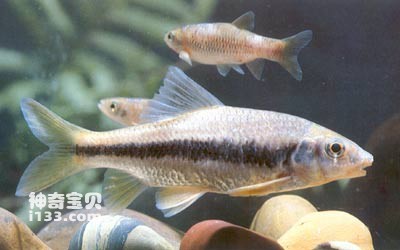Acrossocheilus fasciatus belongs to the order Cypriniformes, family Cyprinidae, subfamily Acrossocheilus, and genus Acrossocheilus fasciatus. Commonly known as: grouper, rosy fish.
The body is slender, with flat sides, a slight bulge on the back of the head, and a round and lightly arced abdomen. The head is medium large, flat on the sides and slightly pointed at the front. The snout is round and blunt, the snout folds are short, the upper lip is not covered, and the edges are smooth; the adult snout has granular horny protrusions. Lower mouth, horseshoe shape. The end of the upper jaw reaches the vertical line of the front edge of the eye, and the upper jaw is surrounded by the lower jaw; the front edge of the lower jaw is almost straight, with sharp horn, and is completely exposed. The upper lip is narrower than the lower lip, and the lower lip is divided into left and right sides. The distance between them is wider, about 1/3 of the mouth width. The posterior labial groove is short, interrupted at the forehead, and has a wide spacing. There are 2 pairs of barbels, both of which are slender. The kissing barbel is about 1/2 of the jaw barbel, and the jaw barbel is slightly larger than the eye diameter. The eyes are large. The outer edge of the dorsal fin is nearly flat, its last unbranched fin is slightly thicker, but its top is soft, and its trailing edge is finely serrated. The scales are medium large, and the pectoral fin scales are smaller; the pelvic fin base has a long axillary scale; the dorsal fin and anal fin scale sheaths are not obvious. The body is grey-brown, the underside is light yellow, and the ventral surface is white; the dorsal fin membrane is grey-brown; there are 6 horizontal bands on the side of the body and 1 dark brown longitudinal band. The longitudinal band of the male fish is obvious, but the transverse band is not obvious; the longitudinal band of the female fish is only slightly obvious at the rear, but the transverse band is obvious.

The light-lipped fish likes to inhabit rivers with gravel bottoms and clear water and fast currents. It often uses its cuticles with well-developed jaws to shovel moss and algae on the rocks. They lay eggs in shallow rapids from June to August every year. Mainly distributed in streams in Shanghai, Jiangsu, Anhui, Zhejiang, Fujian, Taiwan and other places.
Widely distributed, it is a small economic fish in the production area and its meat is delicious. The eggs are toxic and if eaten by mistake, they can cause poisoning symptoms such as diarrhea, abdominal pain, dizziness, vomiting, etc. Cats, chickens and other animals that eat fish eggs can cause death. Prolonged heating can destroy toxins. Due to their bright body color, Zhejiang has selected 3.5 cm juvenile fish of the same type for export in recent years. As ornamental fish, 20,000 to 30,000 fish are exported every year, creating considerable value.
animal tags:
We created this article in conjunction with AI technology, then made sure it was fact-checked and edited by a Animals Top editor.